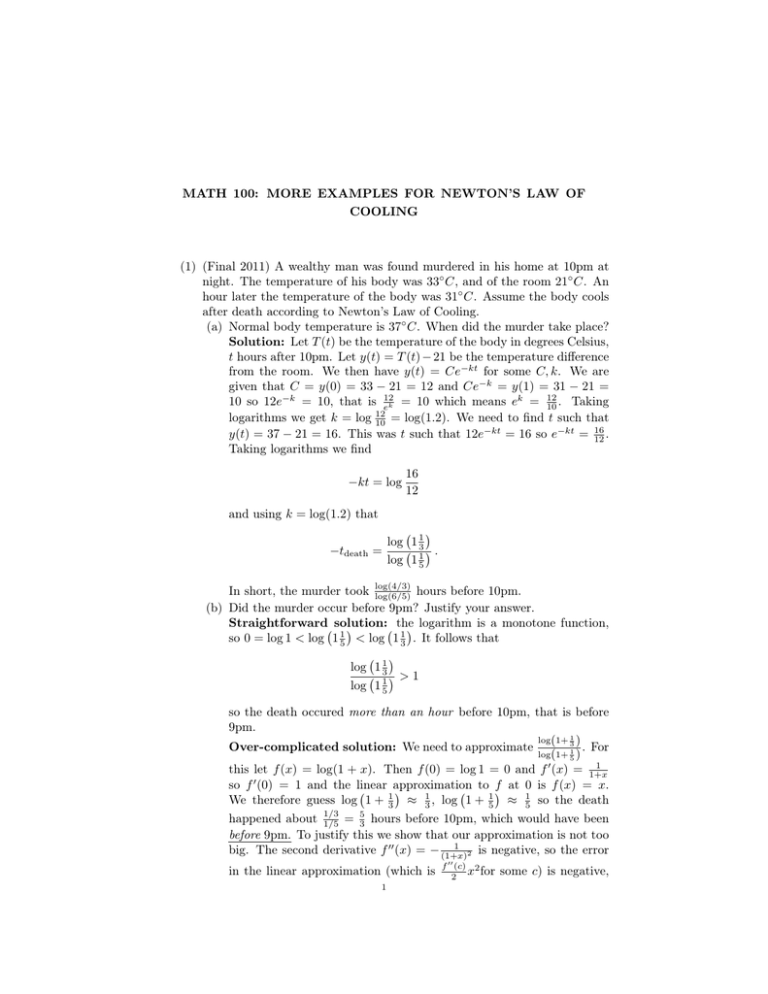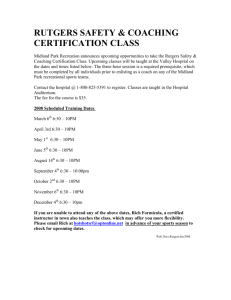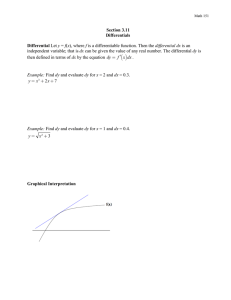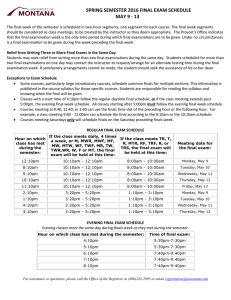MATH 100: MORE EXAMPLES FOR NEWTON’S LAW OF COOLING
advertisement

MATH 100: MORE EXAMPLES FOR NEWTON’S LAW OF COOLING (1) (Final 2011) A wealthy man was found murdered in his home at 10pm at night. The temperature of his body was 33◦ C, and of the room 21◦ C. An hour later the temperature of the body was 31◦ C. Assume the body cools after death according to Newton’s Law of Cooling. (a) Normal body temperature is 37◦ C. When did the murder take place? Solution: Let T (t) be the temperature of the body in degrees Celsius, t hours after 10pm. Let y(t) = T (t) − 21 be the temperature difference from the room. We then have y(t) = Ce−kt for some C, k. We are given that C = y(0) = 33 − 21 = 12 and Ce−k = y(1) = 31 − 21 = 12 . Taking 10 so 12e−k = 10, that is e12k = 10 which means ek = 10 12 logarithms we get k = log 10 = log(1.2). We need to find t such that y(t) = 37 − 21 = 16. This was t such that 12e−kt = 16 so e−kt = 16 12 . Taking logarithms we find −kt = log 16 12 and using k = log(1.2) that −tdeath log 1 31 . = log 1 51 In short, the murder took log(4/3) log(6/5) hours before 10pm. (b) Did the murder occur before 9pm? Justify your answer. Straightforward solution: the logarithm is a monotone function, so 0 = log 1 < log 1 15 < log 1 13 . It follows that log 1 13 >1 log 1 15 so the death occured more than an hour before 10pm, that is before 9pm. log(1+ 1 ) Over-complicated solution: We need to approximate log 1+ 13 . For ( 5) 1 this let f (x) = log(1 + x). Then f (0) = log 1 = 0 and f 0 (x) = 1+x 0 so f (0) = 1 and the linear approximation to f at 0 is f (x) = x. We therefore guess log 1 + 13 ≈ 31 , log 1 + 15 ≈ 15 so the death 1/3 happened about 1/5 = 53 hours before 10pm, which would have been before 9pm. To justify this we show that our approximation is not too 1 big. The second derivative f 00 (x) = − (1+x) 2 is negative, so the error in the linear approximation (which is 1 f 00 (c) 2 2 x for some c) is negative, MATH 100: MORE EXAMPLES FOR NEWTON’S LAW OF COOLING that islog 1 + 1 5 2 ≤ 15 , which means 1 ≥ 5. log 1 + 15 We also note that f 00 (0) = −1 so the quadratic approximation to log is 2 log(1+x) ≈ x− 12 x2 and now the error term involves f 000 (x) = (1+x) 3 > 0. It follows that the quadratic approximation is an under-estimate: that 2 1 1 1 1 1 5 1 ≥ − = − = . log 1 + 3 3 2 3 3 18 18 Multiplying the two estimates gives: log 1 13 5/18 25 −tdeath = 1 ≥ 1/5 = 18 > 1 . log 1 5

![1 = 0 in the interval [0, 1]](http://s3.studylib.net/store/data/007456042_1-4f61deeb1eb2835844ffc897b5e33f94-300x300.png)





